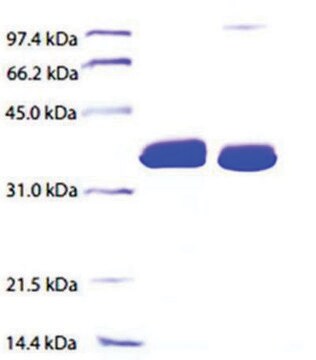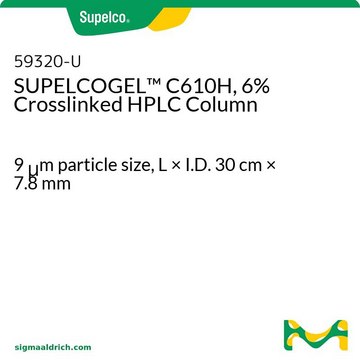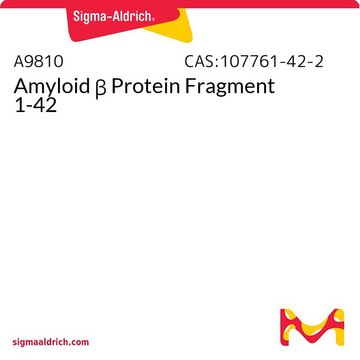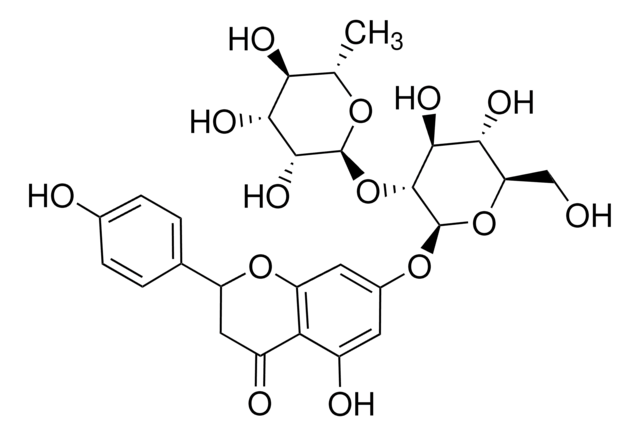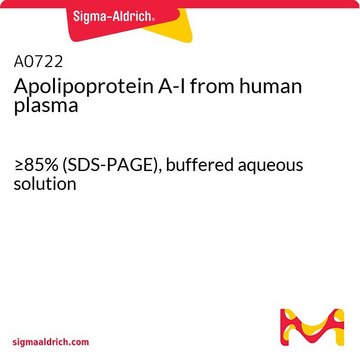A3234
Apolipoprotein E4 human
recombinant, expressed in E. coli, ≥90% (SDS-PAGE and HPLC), lyophilized powder
Synonym(e):
ApoE4
Anmeldenzur Ansicht organisationsspezifischer und vertraglich vereinbarter Preise
Alle Fotos(1)
About This Item
Empfohlene Produkte
Rekombinant
expressed in E. coli
Qualitätsniveau
Assay
≥90% (SDS-PAGE and HPLC)
Form
lyophilized powder
UniProt-Hinterlegungsnummer
Lagertemp.
−20°C
Angaben zum Gen
human ... APOE(348)
Suchen Sie nach ähnlichen Produkten? Aufrufen Leitfaden zum Produktvergleich
Allgemeine Beschreibung
Apolipoprotein E (ApoE) is present in the brain and is mainly produced by astrocytes. It is a 299 amino acid glycoprotein of 34kDa. It is present in all classes of lipoproteins except LDL (low-density lipoprotein). APOE gene has three alleles, such as APOE ε3, APOE ε4 and APOE ε2. It is located on human chromosome 19q13.
Biochem./physiol. Wirkung
ApoE4 (apolipoprotein E4) is associated with AD (Alzheimer′s disease).
Apolipoprotein E4 is a member of the apolipoprotein E family of plasma lipoproteins that bind reversibly with lipoprotein and play an important role in lipid metabolism. ApoE4 regulates plasma lipid levels by increasing the degradation of particles rich in triglycerides and cholesterol. In addition to facilitating solubilization of lipids, these proteins help to maintain the structural integrity of lipoproteins, serve as ligands for lipoprotein receptors, regulate the activity of enzymes involved in lipid metabolism and bind amyloid-β protein, the major component of plaques in Alzheimer′s disease, which it delivers to the microglia, the major scavenger cells of brain. Individuals heterozygous for the ApoE4 allele are at higher risk of late-onset Alzheimer′s disease. ApoE exists in three major isoforms: E2, E3, and E4, which differ from one another by a single amino-acid substitution. Recombinant human ApoE4 is a 34.4 kDa protein containing 300 amino acid residues.
The ApoE4 isoform of ApoE correlates with increased incidence of Alzheimer′s disease, and has been shown to regulate lipid metabolism and bind amyloid-beta. Recombinant ApoE4 retains full biological activity and can be used to study interactions of ApoE4 with amyloid-β, Tau, and LDLR.
Physikalische Form
Lyophillized from a 0.2 μm filtered solution in 20 mM sodium phosphate, pH 7.8.
Lagerklassenschlüssel
11 - Combustible Solids
WGK
WGK 3
Flammpunkt (°F)
Not applicable
Flammpunkt (°C)
Not applicable
Hier finden Sie alle aktuellen Versionen:
Besitzen Sie dieses Produkt bereits?
In der Dokumentenbibliothek finden Sie die Dokumentation zu den Produkten, die Sie kürzlich erworben haben.
Kunden haben sich ebenfalls angesehen
Roles of apolipoprotein E4 (ApoE4) in the pathogenesis of Alzheimer's disease: lessons from ApoE mouse models
Huang Y
Biochemical Society Transactions, 120(4), 702-736 (2011)
Twenty years of the Alzheimer?s disease amyloid hypothesis: a genetic perspective
Tanzi R E and Bertram L
Cell, 120(4), 545-555 (2005)
Lipids and disorders of lipoprotein metabolism
Clinical Biochemistry, 120(4), 702-736 (2014)
Traumatic Brain Injury
Neurobiology of Brain Disorders, 120(4), 219-235 (2015)
Artikel
Alzheimer's disease (AD) is the most common cause of dementia in the elderly and is characterized by gradual loss of cognitive functions.
Unser Team von Wissenschaftlern verfügt über Erfahrung in allen Forschungsbereichen einschließlich Life Science, Materialwissenschaften, chemischer Synthese, Chromatographie, Analytik und vielen mehr..
Setzen Sie sich mit dem technischen Dienst in Verbindung.